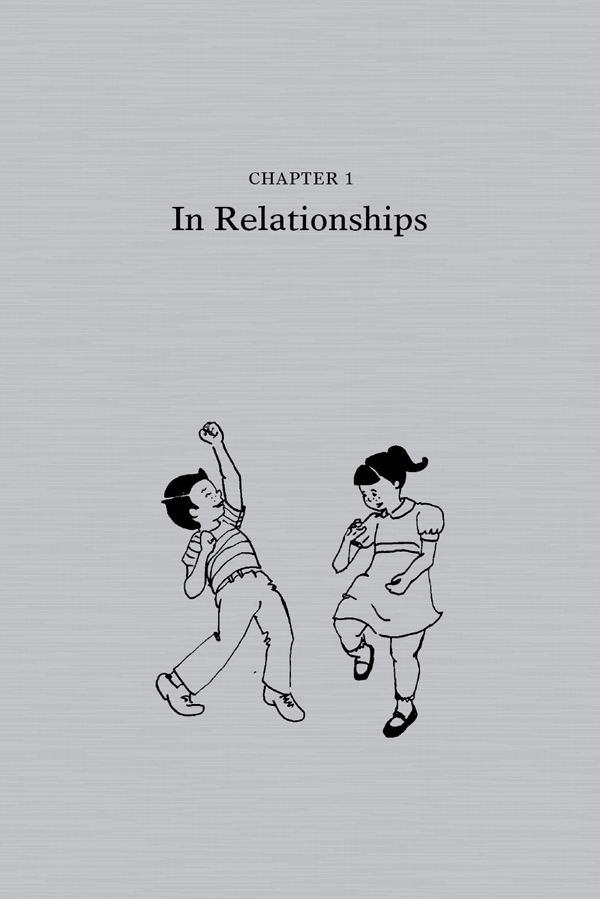FIRST, A NOTE ABOUT YOU
 The first rule of not being a dick to others is: Don’t be a dick to yourself. If you’re vicious to yourself, you’re probably going to be vicious to others, and if you’re vicious to others, other people will be vicious to you. So don’t walk around hating yourself or being a Negative Nancy. That doesn’t help anyone.
The first rule of not being a dick to others is: Don’t be a dick to yourself. If you’re vicious to yourself, you’re probably going to be vicious to others, and if you’re vicious to others, other people will be vicious to you. So don’t walk around hating yourself or being a Negative Nancy. That doesn’t help anyone.
 Let’s say you just went shopping and you bought an awesome new jacket. You like it so much that you don’t want to take it off, so you keep it on even after you come indoors. Some people might find that unusual and ask you why you’re wearing a jacket inside.
Let’s say you just went shopping and you bought an awesome new jacket. You like it so much that you don’t want to take it off, so you keep it on even after you come indoors. Some people might find that unusual and ask you why you’re wearing a jacket inside.
 How do you react? If you feel insecure about yourself and your fashion choices, you might become defensive.
How do you react? If you feel insecure about yourself and your fashion choices, you might become defensive.
But if someone doesn’t appreciate your style sensibility, let your own positivity prevail. Be proud of who you are and stand up for the choices you make.
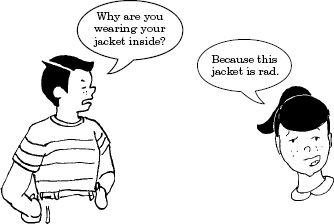
 If you want to wear your jacket inside, then wear your jacket inside. If some people think they can survive without a nice heavy jacket, best of luck to them when the long winter comes.
If you want to wear your jacket inside, then wear your jacket inside. If some people think they can survive without a nice heavy jacket, best of luck to them when the long winter comes.
Comparing Yourself to Others
It’s easy to focus on our own problems and shortcomings. If we’re feeling bored or unhappy, we can’t hide that reality from ourselves, whereas it’s very difficult to see what other people are trying to keep under wraps. So upon seeing a boy playing ping-pong, you might think: “My life’s so boring and dull. I’m so unhappy. If only I could play ping-pong like that boy, things would be different.” There are a lot of nice things in the world and a lot of smiling people, but if you dwell too much on what you don’t have, it’s easy to feel inadequate.
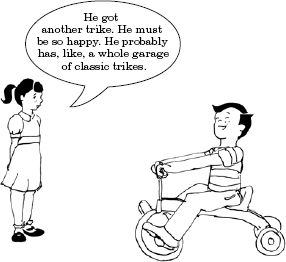
The thing is, the other person could be thinking the same thing about you!
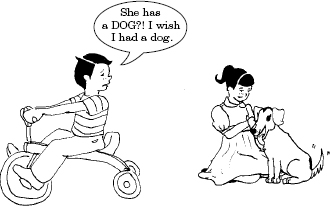
We don’t really have any idea what’s going on in another person’s life. What looks great from the outside might not be so great on the inside.
 Comparing yourself to others distracts you from focusing on yourself and what really matters to you. We have to define success for ourselves and appreciate our own talents. We have to find satisfaction in our own growth and achievements. After all, even when someone seems to have it all—with a hit TV show, piles of money, veins filled with tiger blood, and a goddess on each elbow— deep down, that person might be depressed, flailing, and on the brink of an epic meltdown. Even those who “have it all” are missing things, too.
Comparing yourself to others distracts you from focusing on yourself and what really matters to you. We have to define success for ourselves and appreciate our own talents. We have to find satisfaction in our own growth and achievements. After all, even when someone seems to have it all—with a hit TV show, piles of money, veins filled with tiger blood, and a goddess on each elbow— deep down, that person might be depressed, flailing, and on the brink of an epic meltdown. Even those who “have it all” are missing things, too.
Remember: Success doesn’t always bring happiness, and happiness isn’t always easy to spot.
Body Image
 The world is a big, huge, enormous place covered with billions and billions of people. But guess what? You’re totally unique! Dystopian future cloning technologies aside, you’re the only version of you there will ever be. Embrace it! Nobody is perfect! So don’t worry about your so-called imperfections. Imagine what would happen if some future version of yourself traveled back through time to talk to you today.
The world is a big, huge, enormous place covered with billions and billions of people. But guess what? You’re totally unique! Dystopian future cloning technologies aside, you’re the only version of you there will ever be. Embrace it! Nobody is perfect! So don’t worry about your so-called imperfections. Imagine what would happen if some future version of yourself traveled back through time to talk to you today.
 How embarrassing is that? Instead of obsessing over your latest pimple, do something positive! Join a Sunday- afternoon kickball league, write that graphic novel you’ve been talking about, or really apply yourself at next year’s science fair.
How embarrassing is that? Instead of obsessing over your latest pimple, do something positive! Join a Sunday- afternoon kickball league, write that graphic novel you’ve been talking about, or really apply yourself at next year’s science fair.
Your Feelings
Feelings are the mind’s (and heart’s) way of telling us something we need to know—like that we love someone or that spiders are creepy and evil. But sometimes we don’t know why we feel the way we do. Sometimes, our emotions seem totally out of proportion to whatever caused them.
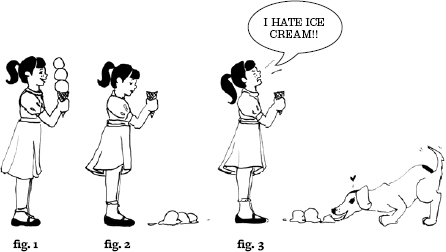
That’s a sign we need to look more closely at what’s going on. Don’t ignore or dismiss your feelings, or you might end up doing something you regret. For instance, say you’re at a friend’s party. Everyone is having a great time, but you’re not.
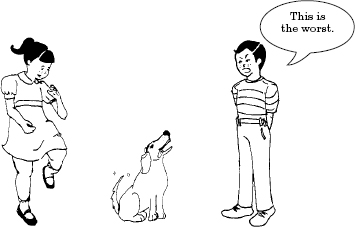
Maybe you blame the host’s dog, who keeps staring at you with those big puppy eyes but who runs away every time you try to pet him. But is the dog really the problem? Take some time to examine why you feel the way you do.
First, identify how you feel.

Next, look for possible causes for your feelings.

Then, understand the connection.

Finally, try to solve the problem in an active way.
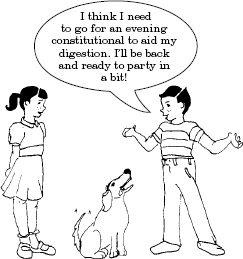
 If you stuff your difficult emotions into a little box and lock them up, you’ll never figure out what’s making you unhappy. You’ll keep experiencing those negative emotions because you won’t be interacting with the real problem. And sure, working through your emotions can take a lot of time and energy (and perhaps a few visits to a professional therapist), but you’re worth it! If you don’t have enough money for a doctor, find a friend to talk to. It can make all the difference.
If you stuff your difficult emotions into a little box and lock them up, you’ll never figure out what’s making you unhappy. You’ll keep experiencing those negative emotions because you won’t be interacting with the real problem. And sure, working through your emotions can take a lot of time and energy (and perhaps a few visits to a professional therapist), but you’re worth it! If you don’t have enough money for a doctor, find a friend to talk to. It can make all the difference.
Honesty Is the Best Policy
 Without honesty, none of the strategies described in this book are going to get you very far. Of course, being honest with yourself is easier said than done. (It would be dishonest not to admit that.) Still, don’t you know deep down when you’re pretending to be someone you’re not? Or when you are just putting on a show to impress others? If we’re pretending to be something just so people will like us, that’s setting ourselves up for trouble. It takes a lot of energy to keep that show up 24/7.
Without honesty, none of the strategies described in this book are going to get you very far. Of course, being honest with yourself is easier said than done. (It would be dishonest not to admit that.) Still, don’t you know deep down when you’re pretending to be someone you’re not? Or when you are just putting on a show to impress others? If we’re pretending to be something just so people will like us, that’s setting ourselves up for trouble. It takes a lot of energy to keep that show up 24/7.
Plus, if you overstate your talents, you’ll only look foolish later.
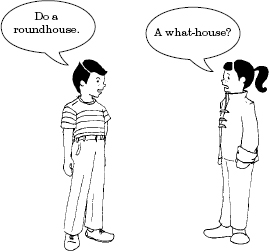
Maybe you want to be a kung fu master, like this young lady. But if you aren’t there quite yet, don’t pretend to be.
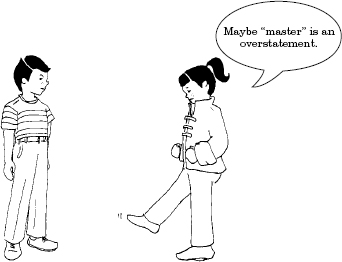
Admit that you’re still learning. People will understand because —think about it—they’re probably in the process of learning something, too. If you don’t know something, don’t be afraid to ask someone who might know. People are naturally attracted to those who are curious and humble and who seek to improve themselves (whether that involves hand-to-hand combat or not).
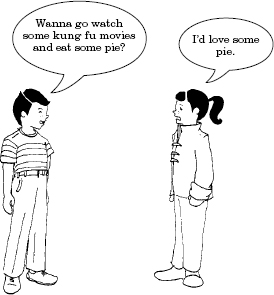
WHEN IT COMES TO OTHERS
 The single most important thing to remember in dealing with other people is: Everyone you meet is an individual and should be treated accordingly. So put yourself in the other person’s shoes—and always get permission from everyone in your video before posting it on YouTube.
The single most important thing to remember in dealing with other people is: Everyone you meet is an individual and should be treated accordingly. So put yourself in the other person’s shoes—and always get permission from everyone in your video before posting it on YouTube.
Making Generalizations
It’s impossible to go through life (not to mention any given day) without making some assumptions. The important thing to remember, however, is that assumptions are just guesses. Even if they’re not flat-out wrong, they are still usually incomplete.
 Assumptions are conclusions based on what we don’t know, rather than what we do. As a result, our assumptions tend to say more about what we believe than about the people we are assuming things about. This young lady might have bangs, wear DIY fashions, and live in a city, but that doesn’t mean she can pickle her own cucumbers.
Assumptions are conclusions based on what we don’t know, rather than what we do. As a result, our assumptions tend to say more about what we believe than about the people we are assuming things about. This young lady might have bangs, wear DIY fashions, and live in a city, but that doesn’t mean she can pickle her own cucumbers.
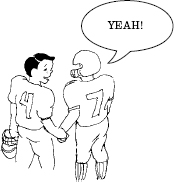 And this young man may be a small- town football hero, but that doesn’t mean that he’s into cheerleaders.
And this young man may be a small- town football hero, but that doesn’t mean that he’s into cheerleaders.
Stereotypes based on race, gender, sexuality, nationality, or anything else—Star Trek fans, “dirty” hippies, professional athletes, and so forth—mislead us when we come into contact with individuals. Sure, stereotypes might be based on a kernel of truth (most Trekkies are awesome), but that shouldn’t stop us from being open to understanding the unique person standing right in front of us.

After all, one young man might fancy cheese in a can, but does that mean every young man likes cheese in a can?
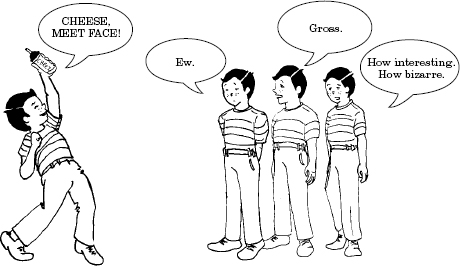
People of Different Cultural Backgrounds
The world has more cultures than you can shake a stick at. It’s a vast place filled with many different people with many different customs. And that’s a good thing!

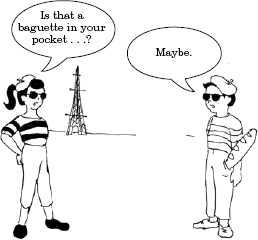 Everyone has something different to bring to the table. Those differences are what make our world such an interesting place. Vive la différence!
Everyone has something different to bring to the table. Those differences are what make our world such an interesting place. Vive la différence!
People of Different Sexual Orientations
We can’t help who we love. That’s what the scientific evidence suggests, and that’s what our hearts tell us, too.
Just because one person is straight doesn’t mean that everyone else has to be. And just because one person is not straight also doesn’t mean that everyone else has to be. There’s room on this spinning globe for all of us, so follow the Golden Rule and treat people of different sexual orientations as you would want to be treated.

People of Different Religious Faiths
Of course, along with all the other differences that make our world go round is the fact that people hold a wide variety of religious and spiritual beliefs. Questions about how we got here and what we’re supposed to be doing with our time on Earth are an essential aspect of nearly every spiritual tradition.
 Religions rely on belief for answers to many of these essential (and existential) questions. And believing in an idea is kind of like falling in love with a person —it just seems right, even if we can’t fully explain it. That’s okay, but it can lead to disagreements. We don’t have to all believe the same thing. Allow people to have their own beliefs, even if those beliefs are different from your own. We’ll all get along better if we’re free to explain the whys and wherefores of our beliefs without feeling patronized or bullied. And that’s the whole point, right?
Religions rely on belief for answers to many of these essential (and existential) questions. And believing in an idea is kind of like falling in love with a person —it just seems right, even if we can’t fully explain it. That’s okay, but it can lead to disagreements. We don’t have to all believe the same thing. Allow people to have their own beliefs, even if those beliefs are different from your own. We’ll all get along better if we’re free to explain the whys and wherefores of our beliefs without feeling patronized or bullied. And that’s the whole point, right?

People of Different Abilities
Treating people who are disabled goes back to the Golden Rule, “Treat others as you would want to be treated.” Just because some are born hard of hearing, for instance, doesn’t mean that they don’t want the same things out of life that everyone else does or couldn’t perform many, if not all, of the same tasks. Don’t make assumptions about what people with disabilities can or cannot do, just as you wouldn’t make such assumptions about anyone else.
Another point to remember is what might be considered a “disability” by an outsider may very well be a nonissue for that person—or a point of pride.

Young People
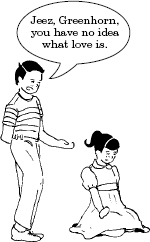 Unless you were just born this very second (in which case, congratulations on your incredible reading comprehension skills!), there are a lot of people who are younger than you—and probably less experienced as a result. But even though you may have seen more of the world, that doesn’t mean that they don’t have knowledge to share or have a valid perspective. Maybe you’ve been through a million romantic breakups, but you shouldn’t negate others’ experiences just because it’s their first time.
Unless you were just born this very second (in which case, congratulations on your incredible reading comprehension skills!), there are a lot of people who are younger than you—and probably less experienced as a result. But even though you may have seen more of the world, that doesn’t mean that they don’t have knowledge to share or have a valid perspective. Maybe you’ve been through a million romantic breakups, but you shouldn’t negate others’ experiences just because it’s their first time.
 Help that youngster by sharing your experience, but also by asking questions. This is the most useful way to help others learn from their experiences.
Help that youngster by sharing your experience, but also by asking questions. This is the most useful way to help others learn from their experiences.
 Who knows? You might gain something, too. Perhaps a new strategy for dealing with heartache or just a new and improved sense of how fast kids grow up.
Who knows? You might gain something, too. Perhaps a new strategy for dealing with heartache or just a new and improved sense of how fast kids grow up.
The Elderly
Guess what? There will also always be people older than you, too! Hurray for aging! Just note: Older often means wiser, but not always. Life on Earth takes its toll, and some have paid larger tolls than others.
Don’t assume that just because people are older that they are also “out of touch.” If they’ve earned the right to a senior discount at the movie theater, cut them some slack.

 Aging is hard, but experience brings wisdom. So listen up every chance you get. Those who have gone before you can be your guide to the life ahead of you.
Aging is hard, but experience brings wisdom. So listen up every chance you get. Those who have gone before you can be your guide to the life ahead of you.
If all goes well and you make it to old age, you’ll be facing the same serious challenges they are. Wouldn’t you hope for an understanding, kind, young-ish person to help you and listen to your awesome stories?
IN CONVERSATION
 Whoever you are, wherever you’re going, and whatever you want to do, you’re going to need to talk to people. How else are you going to communicate? With passiveaggressive post-its?
Whoever you are, wherever you’re going, and whatever you want to do, you’re going to need to talk to people. How else are you going to communicate? With passiveaggressive post-its?
No thanks. Just use your words. The words you use and the way you talk to people says a lot about who you are. They also help determine whether or not people will listen to you.
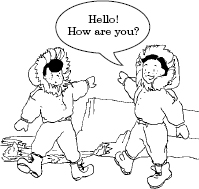 Greeting Others
Greeting Others
Whenever you encounter someone—whether crossing an ice floe in Antarctica or just passing on a crowded street—it’s always polite to say, “Hello.” This is often followed by, “How are you?”
This simple acknowledgment of another person is Politeness 101. Use it often!
Initiating a Conversation
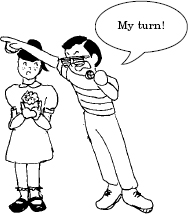 Sometimes you might want to say more than hello. You might have an issue to discuss, or you might see someone that you’d like to get to know better. In these cases, make sure the person isn’t already busy or engaged in another conversation. Don’t just butt in and start talking. That’s rude!
Sometimes you might want to say more than hello. You might have an issue to discuss, or you might see someone that you’d like to get to know better. In these cases, make sure the person isn’t already busy or engaged in another conversation. Don’t just butt in and start talking. That’s rude!
 Interrupting not only derails the original conversation, it also makes you look like a total dick! So play it cool.
Interrupting not only derails the original conversation, it also makes you look like a total dick! So play it cool.
 Seriously, just wait your turn. Stand close but not too close, and eventually the talkers will get the hint and pause, allowing you to introduce yourself.
Seriously, just wait your turn. Stand close but not too close, and eventually the talkers will get the hint and pause, allowing you to introduce yourself.
Congratulations, you just started a conversation! Keep practicing!

Once you’ve introduced yourself, immediately address the subject you want to discuss. However, if the person is a stranger, take things more slowly than you would with a friend or acquaintance. Start by asking a question about that person or perhaps by commenting on something you can both see in the surrounding area.

 Once the conversation is started, you can springboard into more in-depth topics. Or you can get to the point.
Once the conversation is started, you can springboard into more in-depth topics. Or you can get to the point.
Personal Space
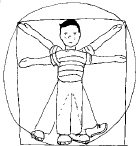 When we talk with someone, our bodies say a lot. It’s important to maintain proper personal space. Allow an arm’s length distance between you and the person you’re speaking with, aka “the interlocutor.” This gives your interlocutor some breathing room. People are more at ease and communicate better when they don’t feel hemmed in or threatened.
When we talk with someone, our bodies say a lot. It’s important to maintain proper personal space. Allow an arm’s length distance between you and the person you’re speaking with, aka “the interlocutor.” This gives your interlocutor some breathing room. People are more at ease and communicate better when they don’t feel hemmed in or threatened.
Hovering is a sure-fire way to make someone feel instantly uncomfortable. It’s easy to do if you’re not on the lookout. How do you know when you’re too close?
 You look over someone’s shoulder.
You look over someone’s shoulder.
 You stand just behind or next to someone.
You stand just behind or next to someone.
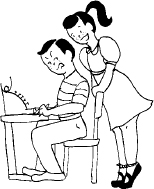 You stand over someone who is sitting.
You stand over someone who is sitting.
Standing while someone is sitting sends a message about who is in charge of the conversation. It creates a real power imbalance.
Eye Contact
If you’re talking with someone you’re really attracted to, you might be tempted to take this opportunity to appreciate all aspects of his or her physical appeal. A word of advice, however: Save it for later! During a conversation, take care to maintain eye contact. This communicates that you’re a sincere, respectful individual who is genuinely interested in what the other person is saying.
By staring at areas other than the face, you may make the other person uncomfortable. It’s hard not to notice someone looking at you in an inappropriate way.

Give others the respect of looking at them in the eye when

Asking Questions
Questions are an essential part of any conversation, particularly with someone you’re trying to get to know better. They keep things dynamic. Or at least, they can if you ask the right ones. Avoid questions that require only a “yes” or “no” answer.

 Instead, try to ask open-ended questions. These demonstrate an engaged mind, since they ask us to think and maybe get off our established script. As questions lead to answers (which lead to more questions, and so on and so on), you will discover what truly makes people tick and get a better sense of whether or not you really want to be spending any more time with them.
Instead, try to ask open-ended questions. These demonstrate an engaged mind, since they ask us to think and maybe get off our established script. As questions lead to answers (which lead to more questions, and so on and so on), you will discover what truly makes people tick and get a better sense of whether or not you really want to be spending any more time with them.
Active Listening
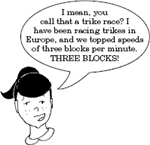 Listening sounds easy enough, but it can take real work. Words have to be deciphered and understood. It takes considerable effort and energy to stay focused while someone is offering an in-depth account of his or her deepest passion.
Listening sounds easy enough, but it can take real work. Words have to be deciphered and understood. It takes considerable effort and energy to stay focused while someone is offering an in-depth account of his or her deepest passion.
 When in conversation, show that you’re listening by asking focused questions. Demonstrate your interest by repeating back some of the most provocative points and then engaging in some new way. It may be hard, but it can have a huge impact on the quality of the overall conversation—and on the other person’s opinion of you.
When in conversation, show that you’re listening by asking focused questions. Demonstrate your interest by repeating back some of the most provocative points and then engaging in some new way. It may be hard, but it can have a huge impact on the quality of the overall conversation—and on the other person’s opinion of you.
Actively Not Listening
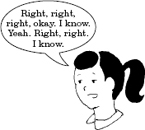 Even when we are listening, one bad habit we often fall into is the stock response. We overuse reaction words such as “right,” “okay,” “yeah,” and “uh huh.” Repeatedly making these sounds gives the impression we’re not actually interested. They also interrupt the flow of the other person’s story.
Even when we are listening, one bad habit we often fall into is the stock response. We overuse reaction words such as “right,” “okay,” “yeah,” and “uh huh.” Repeatedly making these sounds gives the impression we’re not actually interested. They also interrupt the flow of the other person’s story.
Convey active listening with an expression of concentration and wait for the person to pause before responding. Avoid adding interjections after every sentence.
After all, patterned responses often provide us with the wrong word at the wrong time.
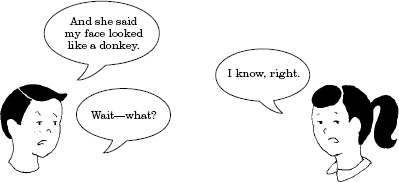
Sometimes as we’re listening, ideas occur to us that have little to no relationship to the conversation. What’s on our mind may seem more important than what the other person is saying, but it’s still rude to change topics too abruptly.

At best, this makes it look like you don’t value the conversation; at worst, it makes it seem like you don’t value the person. So even when you are listening and want to bring up something new, take care to provide a smooth transition.
And if you miss something, instead of pretending that you got it, just ask the person to repeat what you missed.

Talking About Yourself
When having a conversation with someone, avoid talking about yourself too much. Of course, no one is better qualified to talk about you than you, but by the same token, the other person generally won’t be as interested in you as you think. To avoid disappointment (and the reputation of being self-centered), continually turn the conversation back to the other person. How can you tell if you’re hijacking the conversation? If it looks like this:

Remember: Be courteous and share the conversation! Your turn to speak will come … eventually.

Acting Cool
When your turn to talk does comes up, be yourself! Don’t tailor your identity to the other person’s expectations.

 The real you is way more interesting! Besides, it’s too much work to keep up a façade. Be honest about who you are and what you’re looking for, and you’ll attract people who appreciate you for you. Be upfront about your hobbies and interests.
The real you is way more interesting! Besides, it’s too much work to keep up a façade. Be honest about who you are and what you’re looking for, and you’ll attract people who appreciate you for you. Be upfront about your hobbies and interests.
TMI
Okay, back up for a second. That advice about total honesty doesn’t apply to everything. When meeting someone for the first time, try to avoid personal topics, such as breakups, sexual liaisons, rashes, gossip about common friends, and monologues about how your parents ruined your life.
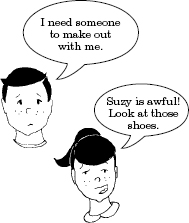
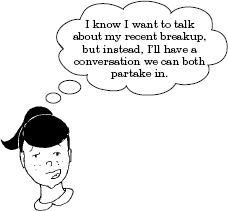 Before speaking, think: “If I typed this in an email and sent it to my entire address book, would I be embarrassed?” If so, save the conversation for a more intimate setting. It’s great to be honest, but show some tact and discretion.
Before speaking, think: “If I typed this in an email and sent it to my entire address book, would I be embarrassed?” If so, save the conversation for a more intimate setting. It’s great to be honest, but show some tact and discretion.
Humor
Humor is a great addition to any conversation. Everyone enjoys a good laugh. Laughter brings us closer together. However, remember that not everyone finds the same things amusing.

Jokes that belittle others or trade in stereotypes—particularly if they make fun of some aspect of the person you’re with—can backfire. A bad joke is one thing, but intolerance is no laughing matter.

So stay away from jokes based on racial, ethnic, cultural, or gender stereotypes. And if someone makes a tasteless joke, let that person know that kind of humor is wrong and only peddled by dicks and stand-up comics looking to express their inner regret.
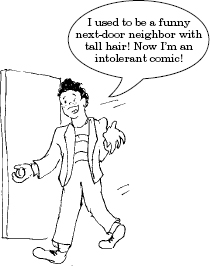
If you hear a joke that isn’t based on hate or stereotypes, don’t be afraid to pass it on!

Asking for Someone’s Phone Number
Few things are more anxiety producing than asking for someone else’s phone number (because rejection stinks!). Despite all the effort you’ve put into active listening, the person might still say no.
Of course, people might have a good reason for not giving you their phone number, and it might have nothing to do with you. Maybe they’re in a relationship, or maybe they just want to enjoy a night with their friends.
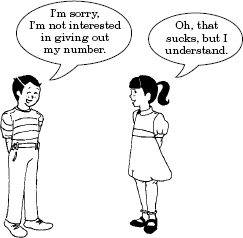
 So, just accept that things might not turn out, and that’s okay! There are tons of fish in the sea. If you react with anger, it will only make things worse.
So, just accept that things might not turn out, and that’s okay! There are tons of fish in the sea. If you react with anger, it will only make things worse.
And if the person says yes, then ask politely to exchange phone numbers so that you both share the calling power!
Ending a Conversation
All good things must come to an end, and that goes for conversations, too. To avoid any awkwardness, be as upfront as possible. Let the other person finish his or her sentence, then nip things off firmly.

If you want to go because the other person has said something truly offensive or won’t stop looking at you inappropriately, don’t descend to her level.
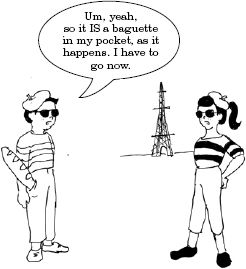
If someone really is being a dick, you don’t want to prolong things or provoke even worse dickish behavior.
IN A FIGHT
If you spend a lot of time around people—whether in class, at your job, in social circles, or in a relationship— disagreements and squabbles are bound to happen. Fighting is a natural part of life, and sometimes arguments help clear the air.
So if you find yourself in a fight, don’t fret! Just be careful not to get carried away. When emotions run high, people can often say or do things that they will later regret. How you fight makes all the difference.
Pick Your Battles
When you find yourself in a disagreement with someone, first take a breath and ask yourself, “Is this fight worth it?”
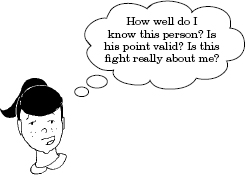
 Sometimes, the subject of an argument isn’t worth fighting over, and the best strategy is to agree to disagree. Each person’s point of view can be valid. If you try to convince other people that they’re wrong, you run the risk of saying something mean and making the argument personal.
Sometimes, the subject of an argument isn’t worth fighting over, and the best strategy is to agree to disagree. Each person’s point of view can be valid. If you try to convince other people that they’re wrong, you run the risk of saying something mean and making the argument personal.
Consider whether what you are saying is really contributing to a constructive discussion.

 Remember, you have to pick your battles. A canine POTUS (“The 45th President of the United States, Eddie Crane!”) may be an incredibly adorable idea, but is it really worth fighting about?
Remember, you have to pick your battles. A canine POTUS (“The 45th President of the United States, Eddie Crane!”) may be an incredibly adorable idea, but is it really worth fighting about?
In the end, what’s more important: winning the argument or saving your relationship?
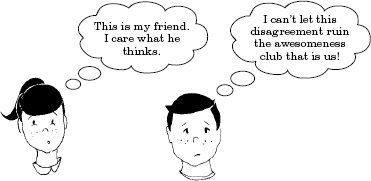
See the Other Side
When emotions flare and tempers are high, it’s hard to think straight, let alone say what you mean—especially when you’re both shouting each other down. Try to allow the other person to finish, no matter how right or wrong you think he is. Take a moment to try to see his side of things. You might learn something.
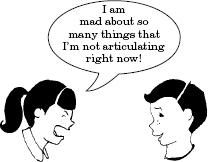
The other person will probably say some things that you do not agree with, but now is not the time to interrupt. After all, just think how frustrating it is when someone interrupts you. It can often cause us to boil over.

Think Before You Speak
Once the other person has finished, it’s your turn to have the floor—but wait! Once again, take a breath and think before you speak. The other party may have said some hurtful things, and you might want to return the favor.

But won’t that only make things worse? Count to ten slowly, and let yourself calm down. Then start by recognizing the larger perspective. Not only does this let the person know you care, but taking the high road is the best way to get an argument back on track.

Apologize for Any Wrongdoing
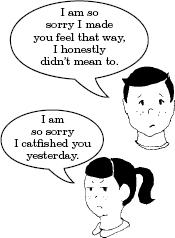 Then, consider if the other person has said anything even remotely accurate at all. Remember, any relationship is a two-way street, and you probably played some part in this fight. Is there any area you can recognize where you were in the wrong? If so, take the time to acknowledge that fact.
Then, consider if the other person has said anything even remotely accurate at all. Remember, any relationship is a two-way street, and you probably played some part in this fight. Is there any area you can recognize where you were in the wrong? If so, take the time to acknowledge that fact.
Take Responsibility for Your Feelings
Let’s just say, for example, that the other person has said some mean things that have made you very angry.

Those angry feelings are your responsibility. Before you can discuss the issue at hand, you have to express your feelings—preferably with a well-crafted “I” statement. After all, that young lady isn’t saying you’re a bad person. She is just expressing her personal opinion about the flavor of your logs.
 If you attack the other person, that will put her on the defensive. Only you can control how you feel. So focus on solving the problem without letting emotions get in the way. That’s the best way to find a solution that will work for everyone.
If you attack the other person, that will put her on the defensive. Only you can control how you feel. So focus on solving the problem without letting emotions get in the way. That’s the best way to find a solution that will work for everyone.
